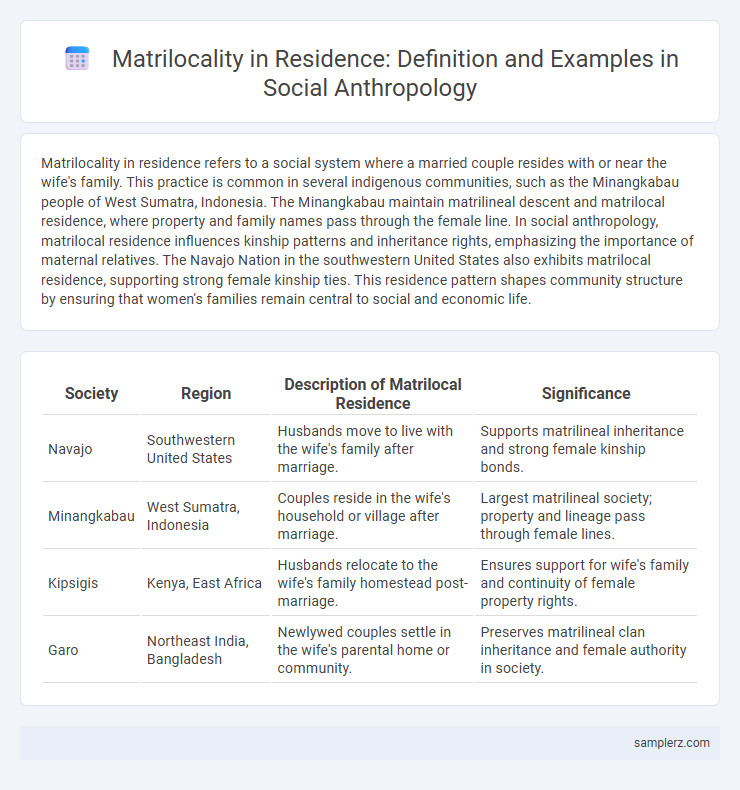Matrilocality in residence refers to a social system where a married couple resides with or near the wife's family. This practice is common in several indigenous communities, such as the Minangkabau people of West Sumatra, Indonesia. The Minangkabau maintain matrilineal descent and matrilocal residence, where property and family names pass through the female line. In social anthropology, matrilocal residence influences kinship patterns and inheritance rights, emphasizing the importance of maternal relatives. The Navajo Nation in the southwestern United States also exhibits matrilocal residence, supporting strong female kinship ties. This residence pattern shapes community structure by ensuring that women's families remain central to social and economic life.
Table of Comparison
| Society | Region | Description of Matrilocal Residence | Significance |
|---|---|---|---|
| Navajo | Southwestern United States | Husbands move to live with the wife's family after marriage. | Supports matrilineal inheritance and strong female kinship bonds. |
| Minangkabau | West Sumatra, Indonesia | Couples reside in the wife's household or village after marriage. | Largest matrilineal society; property and lineage pass through female lines. |
| Kipsigis | Kenya, East Africa | Husbands relocate to the wife's family homestead post-marriage. | Ensures support for wife's family and continuity of female property rights. |
| Garo | Northeast India, Bangladesh | Newlywed couples settle in the wife's parental home or community. | Preserves matrilineal clan inheritance and female authority in society. |
Understanding Matrilocality in Social Structures
Matrilocality is a social residence pattern where a married couple lives near or with the wife's family, a practice common among the Mosuo people of China, known for their matrilineal descent and female-centered households. This system fosters strong kinship bonds among women, ensures inheritance through the maternal line, and supports communal child-rearing within the wife's lineage. Matrilocal residence shapes social roles and power dynamics by emphasizing women's authority in family and community decisions.
Classic Examples of Matrilocal Residence Worldwide
Classic examples of matrilocal residence include the Mosuo people of China, who maintain households where husbands move to live with their wives' families. The Minangkabau of Indonesia, the world's largest matrilineal society, also practice matrilocal residence, emphasizing female lineage dominance. Similarly, the Hopi tribe in the southwestern United States upholds matrilocal traditions, with married couples residing near the wife's maternal relatives.
Matrilocality Among the Minangkabau of Indonesia
Matrilocality among the Minangkabau of Indonesia is characterized by husbands moving into their wives' households after marriage, ensuring that property and lineage remain within the maternal line. This residence pattern reinforces the matrilineal inheritance system, where land, homes, and heirlooms are passed down through female relatives. The Minangkabau's matrilocality sustains social cohesion by strengthening women's roles in family and community leadership.
The Khasi People: A Matrilocal Society in India
The Khasi people of Meghalaya, India, exemplify matrilocal residence, where upon marriage, husbands move into the wife's maternal home. Property and lineage pass through the female line, reinforcing women's central role in family and community structure. This matrilineal and matrilocal system promotes strong kinship bonds and societal stability within Khasi culture.
Matrilocal Tradition Among the Mosuo of China
The Mosuo people of China exemplify matrilocal residence, where married couples live in the wife's family home, ensuring property and lineage pass through the female line. This tradition supports strong female-centered households and communal child-rearing practices, with women managing agricultural work and social affairs. Matrilocality among the Mosuo fosters social stability and reinforces matrilineal inheritance within their unique cultural framework.
The Role of Matrilocality in Native American Tribes
Matrilocality in Native American tribes, such as the Iroquois and Hopi, centered residence patterns around the wife's family, reinforcing female lineage and kinship bonds. This form of residence promoted collective land stewardship and resource management by women, which strengthened social cohesion and cultural continuity within these communities. The matrilocal system also shaped political organization, often granting women significant influence in tribal decision-making and leadership roles.
Matrilocal Residence in African Societies: The Akan Example
Matrilocal residence among the Akan of Ghana involves newly married couples residing near the wife's family, reinforcing matrilineal inheritance and social cohesion. This system supports female lineage continuity by ensuring property and lineage pass through the mother's side, strengthening clan ties and communal responsibilities. The Akan matrilocal practices preserve cultural identity and social structure through residence patterns centered around maternal kinship.
Pacific Island Communities Practicing Matrilocality
Pacific Island communities such as the Trobriand Islanders of Papua New Guinea exemplify matrilocal residence patterns, where married couples live near or with the wife's family. This system strengthens female kinship bonds and ensures maternal lineage continuity, often influencing inheritance and social status. Matrilocality in these societies supports communal cooperation and cultural traditions centered around women's roles.
Social Implications of Matrilocal Living Arrangements
Matrilocal residence, where a married couple lives near or with the wife's family, fosters strong kinship bonds and enhances women's social status within the community. This arrangement often leads to increased cooperation in childcare and resource sharing, shaping gender roles and alliances around maternal lineage. Communities practicing matrilocality frequently exhibit greater female influence in decision-making, promoting social stability and collective well-being.
Comparing Matrilocal and Patrilocal Residence Patterns
Matrilocal residence patterns, where a married couple resides near or with the wife's family, are common among the Minangkabau of Indonesia, emphasizing female lineage and inheritance. In contrast, patrilocal residence patterns, prevalent in many South Asian societies, prioritize residence near the husband's family, reinforcing male authority and lineage continuity. These differing residence patterns significantly influence social organization, inheritance rights, and kinship roles in their respective cultures.

example of matrilocality in residence Infographic
 samplerz.com
samplerz.com